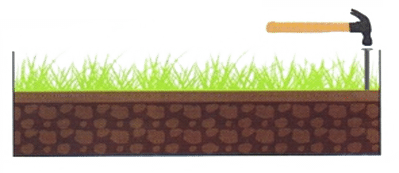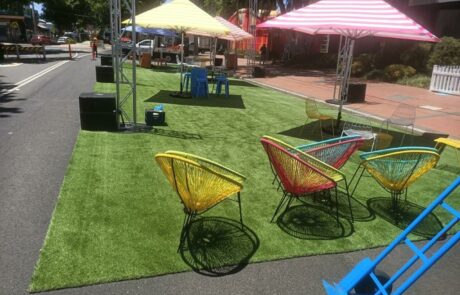Trusted by
Create a Lush, Low-Maintenance Oasis with DIY Synthetic Grass
Are you looking to transform your Melbourne backyard into a stunning, low-maintenance oasis?
With its natural look and feel, DIY synthetic grass offers the perfect solution for those seeking an evergreen, water-efficient landscape. That means saying goodbye to mowing, weeding, and watering, and saying hello to more leisure time.
At Reelgrass, we understand some homeowners are looking to tackle exciting home improvement projects on their own. That’s why we make installing artificial grass a breeze.
With DIY solutions, you can start by preparing the area, removing debris, and levelling the ground. Then, simply lay down a weed barrier and add a compacted base of crushed rock and sand. Unroll your synthetic turf, trim the edges, and secure it with adhesives or landscape staples.
It’s that easy to make the synthetic switch!
If you’re ready to enjoy year-round beauty without the hassle, learn more about our DIY synthetic grass solutions by contacting a member of the Reelgrass team today on 1300 306 389.
Can I DIY a synthetic lawn?
Absolutely! A DIY approach to synthetic grass installation may be suitable for you if you resonate with any of the following scenarios:
✔ Your Current Lawn is High Maintenance: If your natural grass requires constant mowing, weeding, and watering, and you’re tired of the upkeep, artificial grass can significantly reduce maintenance efforts.
✔ You’re Facing Water Restrictions: With Melbourne’s water restrictions, maintaining a lush lawn might be challenging. It eliminates the need for regular watering, helping you conserve water.
✔ Your Lawn Receives Limited Sunlight: If your backyard receives limited sunlight, natural grass may struggle to thrive. It is more resilient and can flourish in various light conditions.
✔ You’re Looking for a Pet-Friendly Solution: If you have pets that constantly wear down natural grass or create muddy patches, pet-friendly synthetic grass provides a durable and pet-friendly alternative.
✔ You Have Seasonal Allergies: For individuals sensitive to pollen or grass allergies, it offers an allergen-free outdoor space.
✔ You Want Greater Aesthetic Appeal: If you desire a green, well-kept lawn year-round without the hassle of seasonal changes, it maintains its appealing look throughout the year.
✔ You’re Dealing with Erosion Issues: If your landscape experiences erosion problems, it can stabilise the soil and prevent further erosion.
✔ You’re Short on Time: If you have a busy schedule and can’t dedicate time to lawn care, it reduces the time and effort required to keep your outdoor space looking great.
How much does a DIY synthetic lawn cost?
DIY synthetic grass in Melbourne can be a cost-effective way to transform your outdoor space. The cost varies based on several factors, including the quality of the artificial turf, the size of the area to be covered, and any additional materials required for installation.
On average, you can expect to pay anywhere from $ 20 to $40 per square metre. Keep in mind that higher-quality artificial turf may be more expensive but offers better durability and a more realistic appearance.
What other costs do you need to consider?
Base Preparation: This involves clearing and levelling the area where you’ll install the synthetic grass. Costs for base materials and equipment rental can range from $10 to $20 per square metre.
Adhesives and Joining Tape: These are necessary for securing the edges and connecting multiple pieces. Budget around $5 to $10 per square metre for these materials.
Miscellaneous Materials: These may include weed barriers, infill material (optional for added stability), and landscape staples, which could add another $5 to $15 per square metre to the total cost.
Overall, the total cost of a DIY synthetic grass project in Melbourne can vary but usually falls within the range of $30 to $70 per square metre.
How long does DIY synthetic grass take to install?
The time it takes to complete the project in Melbourne can vary depending on several factors, including the size of the area, the complexity of the installation, the experience level of the person or team doing the installation, and the availability of necessary tools and equipment.
As a rough estimate, a typical DIY synthetic grass installation for a small to medium-sized backyard (around 100-200 square metres) could take anywhere from 1 to 3 days to complete. This includes preparing the base, laying down the synthetic grass, trimming and securing the edges, and any additional finishing touches.
For larger areas or more intricate installations with curves, multiple levels, or other landscaping features, the installation time may extend to 4 or more days.
Keep in mind that weather conditions can also impact the installation process. Rain or extreme heat may slow down progress, so it’s best to plan the DIY project during a time when the weather is expected to be favourable.
To ensure a smooth and efficient installation, it’s crucial to thoroughly prepare the area and have all the necessary tools and materials ready before starting the project. If you have limited experience with landscaping or DIY projects, get in touch with a member of the Reel Grass team today for more information on 1300 306 389 and support.
Where can I find the best DIY artificial grass supplier in Melbourne?
Identifying a professional DIY synthetic grass supplier in Melbourne involves considering a few key factors that reflect their expertise and reputation. Here are some ways to identify a reliable and professional supplier:
Quality of Products: A professional supplier will offer high-quality synthetic grass that looks and feels realistic. They should provide detailed information about the materials used, durability, and UV resistance.
Wide Range of Options: Look for a supplier that offers a diverse range of options to cater to different needs and preferences, such as different pile heights, colours, and textures.
Positive Reviews and Testimonials: Check online reviews and testimonials from previous customers to gauge their satisfaction and overall experience with the supplier.
Transparent Pricing: A professional supplier will be transparent about their pricing, providing clear information about the cost and any additional materials required for installation.
Knowledgeable Customer Service: A reputable supplier will have knowledgeable staff who can answer your questions, provide guidance, and help you choose the right synthetic turf for your specific requirements.
Sample Service: Look for suppliers that offer samples of their artificial grass so you can see and feel the product before making a purchase.
Installation Guidelines: Professional suppliers typically provide installation guidelines or resources to assist you in the DIY process. They may offer tips, videos, or written instructions for a successful installation.
Warranty and Return Policy: A reliable supplier will stand behind their products and offer a warranty to provide peace of mind in case of any issues. They should also have a clear return policy for unused products.
Experience and Reputation: Check how long the supplier has been in business and if they have a positive reputation within the industry and among customers.
Affiliations and Certifications: Suppliers affiliated with industry associations or holding certifications demonstrate their commitment to quality and standards.
What are the steps for DIY artificial grass installation?
Step 1
Lay 70mm of crushed rock/roadbase and compact with vibrating plate compactor.

Step 2
Excavate lawn area to a depth of 80mm, clearing the area of existing grass and weeds.

Step 3
Lay a final layer of 10 mm crushed dust or fine Scoria Level with a rake or timber board and compact again. Finally, level out any bumps and low spots and compact a final time. Compaction 3 to 4 times is the key to a good job.

Step 4
Position the grass making sure you start from one edge and roll out. Cut overhanging quantities with a sharp knife.

Step 5
If you have a join, position the 2 pcs so there is a 2-3mm gap between the pcs. Peel back the 2 pcs and lay join tape, fixing to the ground with 2-3 pins. Slowly peel off the backing tape to expose the sticky join tape. Carefully grab the 2 pcs of grass at one end, and “fold” the grass onto the join tape. (Both pieces should be folded to the join tape together – not one at a time).
Make sure no grass is caught underneath (best have another person help you with this job). Once down, walk along the join to bond the grass to the join tape.

Step 6
Once you have covered the complete area, nail all perimeters @30cm intervals with nails or weedmat pins. For the best look, make sure no grass is squashed under the weedmat pins.

Step 7
Top dress the grass with quality kiln dried sand, -a bag of 25kg sand should be spread evenly over 3 – 5m2 (Depending on grass type).

Step 8
For best results, a power broom is used to brush the sand into the pile. The broom is used to pull up and straighten the grass.






























